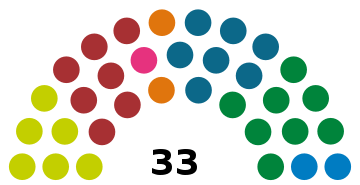Elections in the Faroe Islands
The Faroe Islands elects on national level a legislature. The Faroese Parliament (Løgtingið in Faroese) has 33 members of parliament, elected for a four-year term by proportional representation. The Faroe Islands have a multi-party system (disputing on independence and unionism as well as left and right), with numerous parties in which a single party normally does not have a chance of gaining power alone, and therefore the parties must work together in order to form a coalition government.
 |
|---|
| This article is part of a series on the politics and government of the Faroe Islands |
|
|
|
The unity of the Realm
|
|
Regeringen
The Government of Denmark
Landsstýri
The Government of the Faroe Islands
Privy Council
|
Folketinget
Parliament of the Kingdom of Denmark (69th Kingdom Parliament)
|
|
|
Foreign relations
|
|
Related topics
|
Latest elections
 | ||||||||||||||
| Party | Votes | % | +/– | Seats | +/– | |||||||||
|---|---|---|---|---|---|---|---|---|---|---|---|---|---|---|
| People's Party | 8,290 | 24.5 | 8 | |||||||||||
| Social Democratic Party | 7,480 | 22.1 | 7 | |||||||||||
| Union Party | 6,874 | 20.3 | 7 | |||||||||||
| Republic | 6,127 | 18.1 | 6 | |||||||||||
| Centre Party | 1,815 | 5.4 | 2 | |||||||||||
| Progress | 1,559 | 4.6 | 2 | |||||||||||
| New Self-Government | 1,157 | 3.4 | 1 | |||||||||||
| Cannabis Initiative | 310 | 0.9 | New | 0 | New | |||||||||
| Faroese Party | 167 | 0.5 | New | 0 | New | |||||||||
| Invalid/blank votes | 150 | – | – | – | – | |||||||||
| Total | 33,929 | 100 | 0 | 33 | 0 | |||||||||
| Registered voters/turnout | 37,827 | 89.7 | – | – | ||||||||||
| Source: KVF | ||||||||||||||
Past elections and referendums
- JF – Social-Democrats (Equality Party)
- SF – Union Party (have been in coalition with the Labour Front and the Self-Government Party at some elections)
- TF – Republican Party
- FF – People's Party
- SSF – Self-Government Party
- MF – Centre Party
- KFF – Christian People's Party
- VF – Workers' Movement
- F – Progress
1984
JF – 23.4%, 8 MPs
FF – 21.6%, 7 MPs
SF – 21.2%, 7 MPs
TF – 19.5%, 6 MPs
SSF – 8.5%, 2 MPs
KFF – 5.8%, 2 MPs
1988
FF – 23.2%, 8 MPs
JF – 21.6%, 7 MPs
SF – 21.2%, 7 MPs
TF – 16.2%, 6 MPs
SSF – 7.1%, 2 MPs
KFF – 5.5%, 2 MPs
Others – 2.2%, 0 MPs
1990
JF – 27.5%, 10 MPs
FF – 21.9%, 7 MPs
SF – 18.9%, 6 MPs
TF – 14.7%, 4 MPs
SSF – 8.8%, 3 MPs
KFF – 5.9%, 2 MPs
Others – 2.3%, 0 MPs
1994
SF – 23.4%, 8 MPs
FF – 16.0%, 6 MPs
JF – 15.4%, 5 MPs
TF – 13.7%, 4 MPs
VF – 9.5%, 3 MPs
KFF – 6.3%, 2 MPs
MF – 5.8%, 2 MPs
SSF – 5.6%, 2 MPs
Others – 4.3%, 0 MPs
1998
TF – 23.8%, 8 MPs
JF – 21.9%, 7 MPs
FF – 21.3%, 8 MPs
SF – 18.0%, 6 MPs
SSF – 7.7%, 2 MPs
MF – 4.1%, 1 MPs
KFF – 2.5%, 0 MPs
VF – 0.8%, 0 MPs
Others – 0.8%, 0 MPs
2002
SF – 26.0%, 8 MPs
TF – 23.7%, 8 MPs
JF – 20.9%, 7 MPs
FF – 20.8%, 7 MPs
SSF – 4.4%, 1 MPs
MF – 4.2%, 1 MP
2004
SF – 23.7%, 7 MPs
JF – 21.8%, 7 MPs
TF – 21.7%, 8 MPs
FF – 20.6%, 7 MPs
MF – 5.2%, 2 MPs
SSF – 4.6%, 1 MP
2008
TF – 23.3%, 8 MPs
SF – 21%, 7 MPs
FF – 20.1%, 7 MPs
JF – 19.4%, 6 MPs
MF – 8.4%, 3 MPs
SSF – 7.2%, 2 MPs
Others – 0.7%, 0 MPs
2011
SF – 24.7%, 8 MPs
TF – 23.3%, 8 MPs
FF – 18.3%, 6 MPs
JF – 17.7%, 6 MPs
F – 6.3%, 2 MPs
MF – 6.2%, 2 MPs
SSF – 4.2%, 1 MP
2015
JF – 25.1%, 8 MPs
TF – 20.7%, 7 MPs
FF – 18.9%, 6 MPs
SF – 18.7%, 6 MPs
F – 7.0%, 2 MPs
MF – 5.5%, 2 MPs
SSF – 4.1%, 2 MPs
See also
- Electoral calendar
- Electoral system